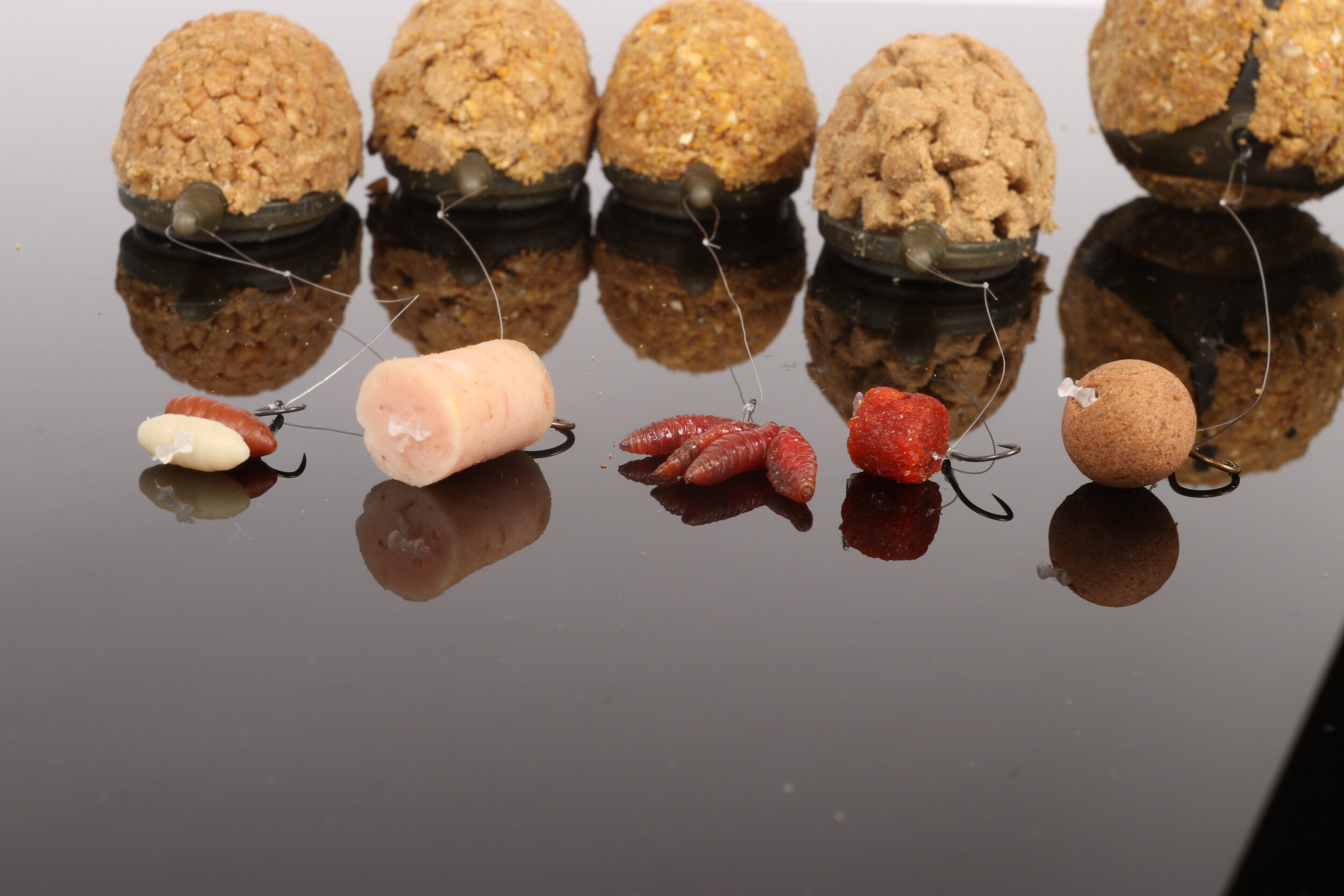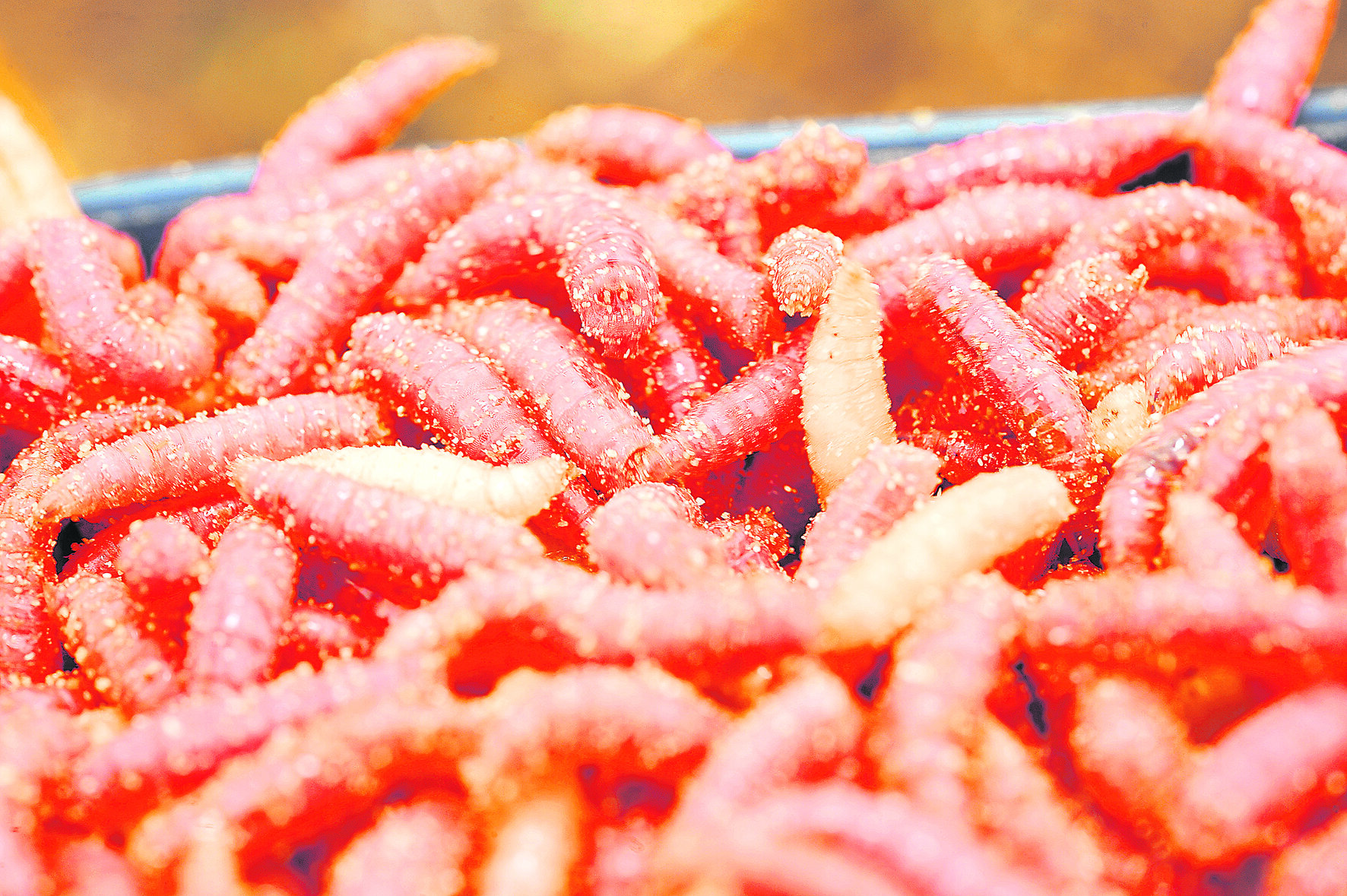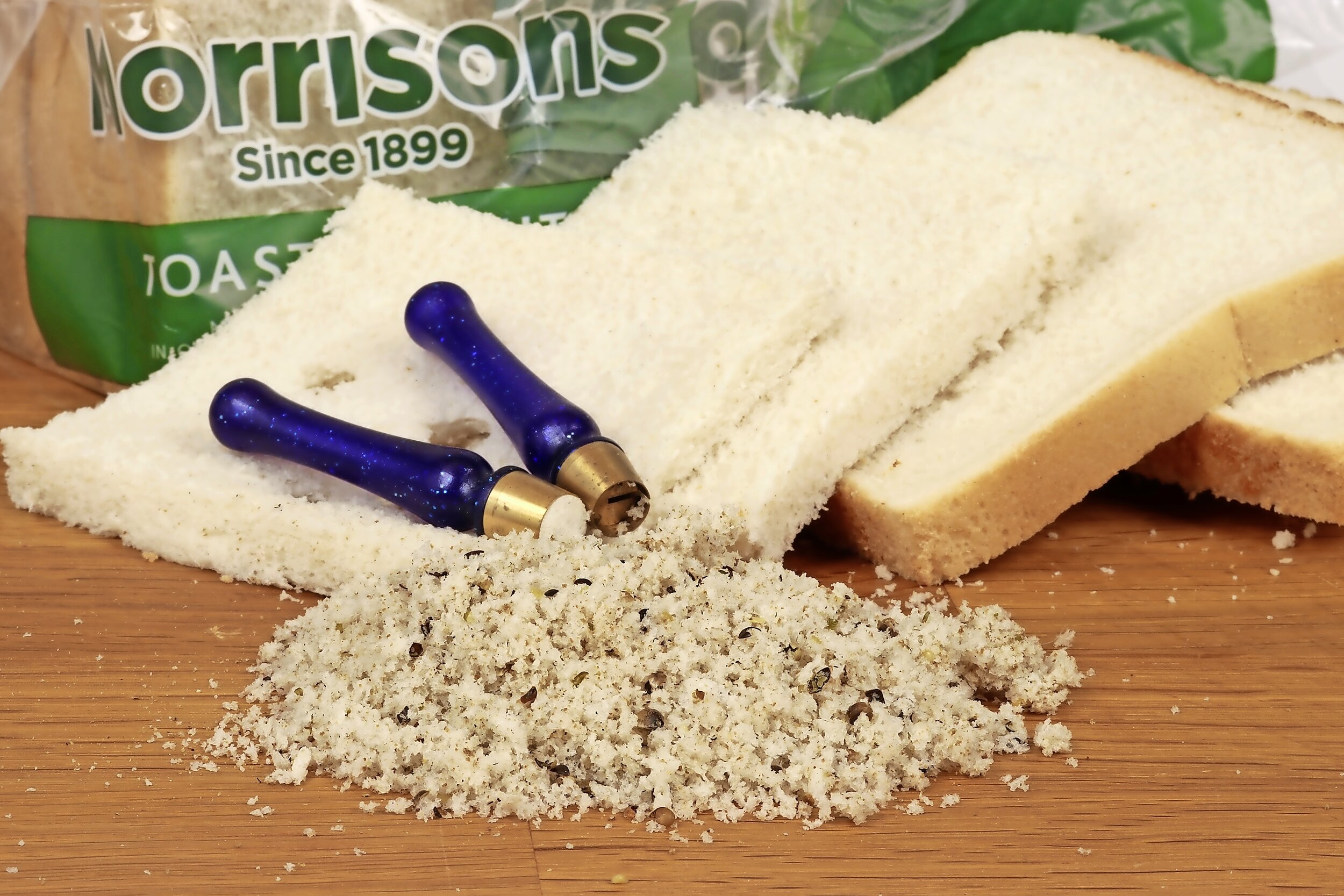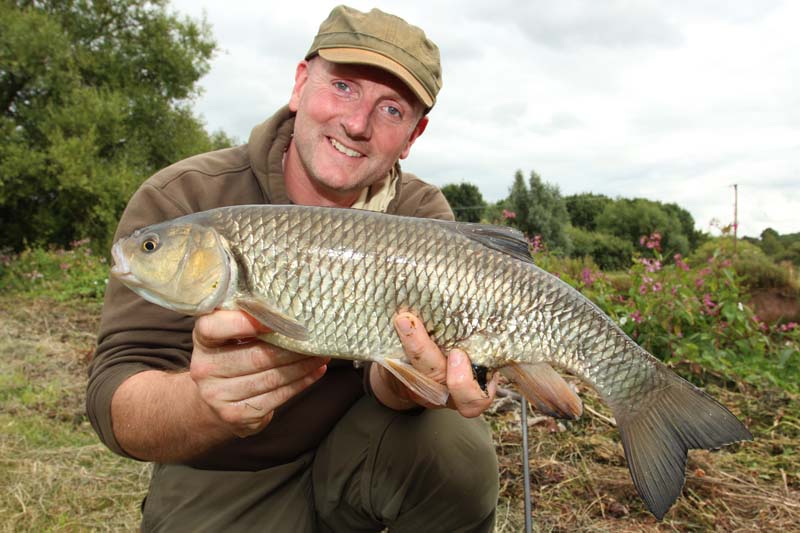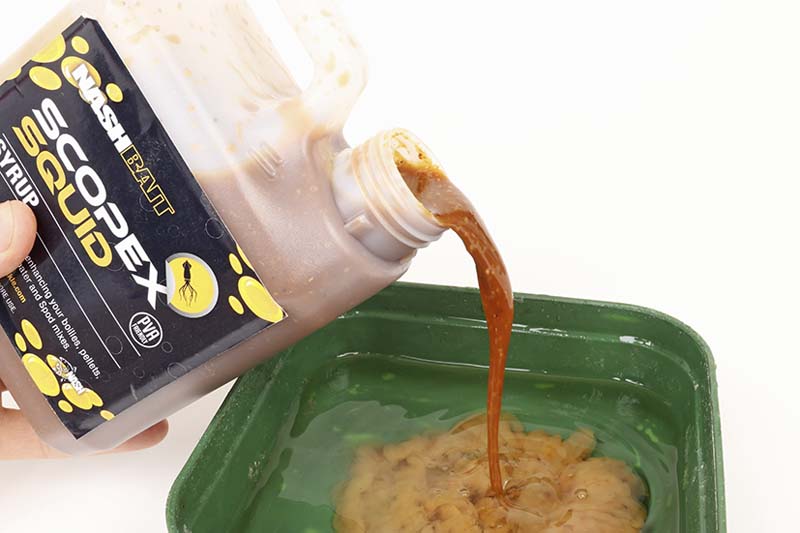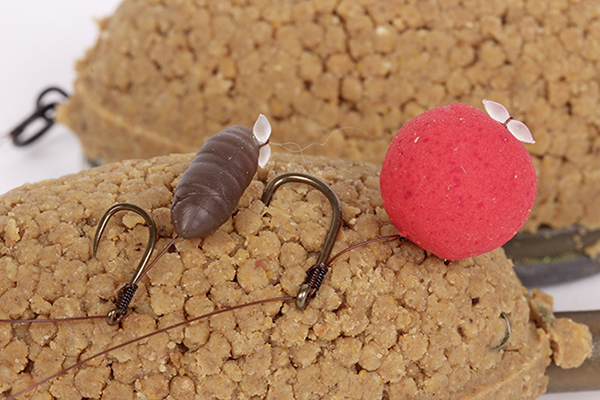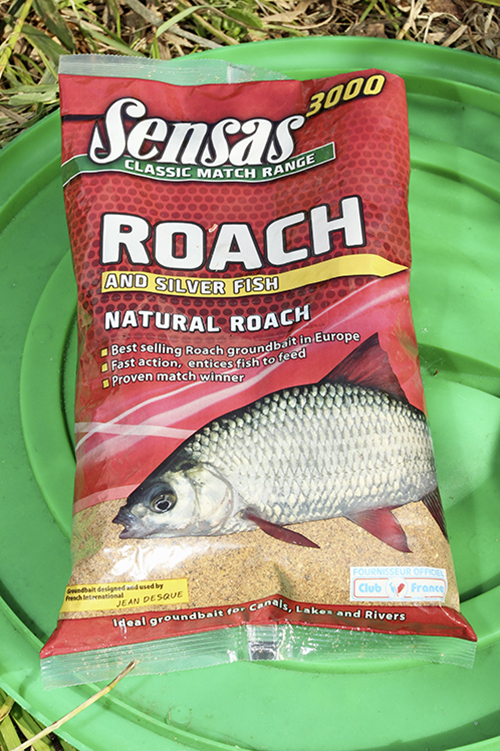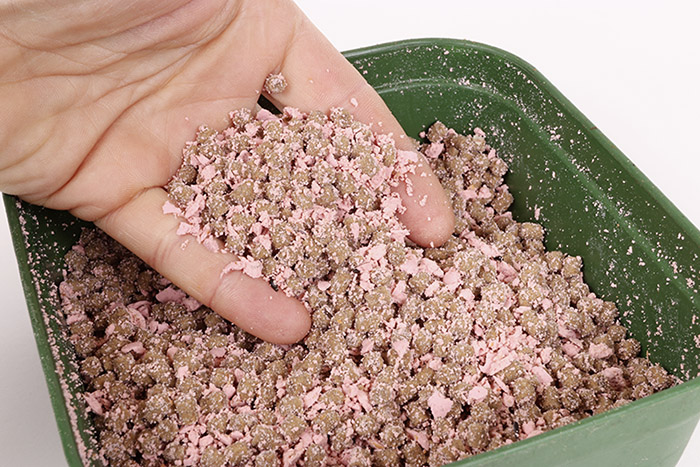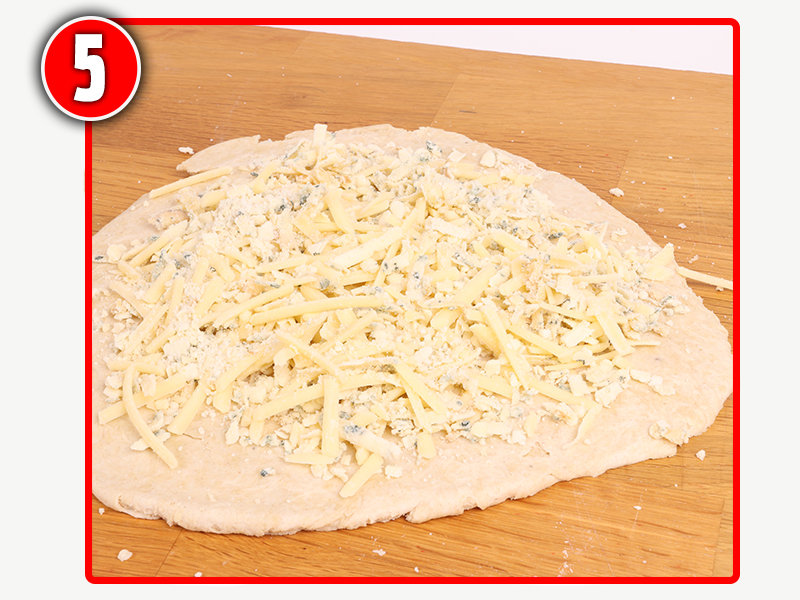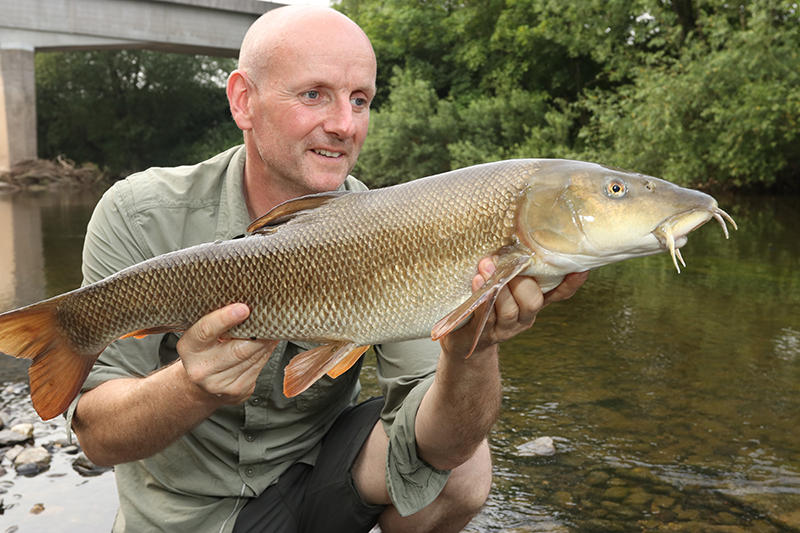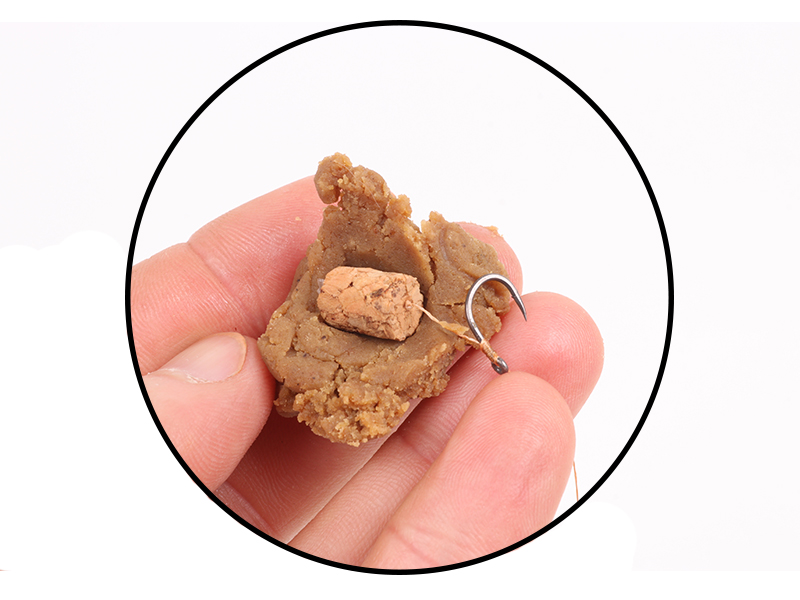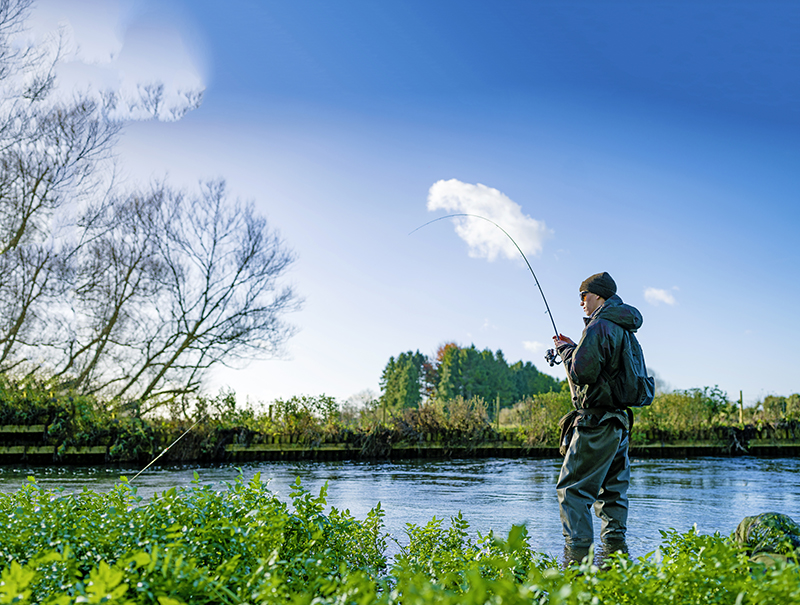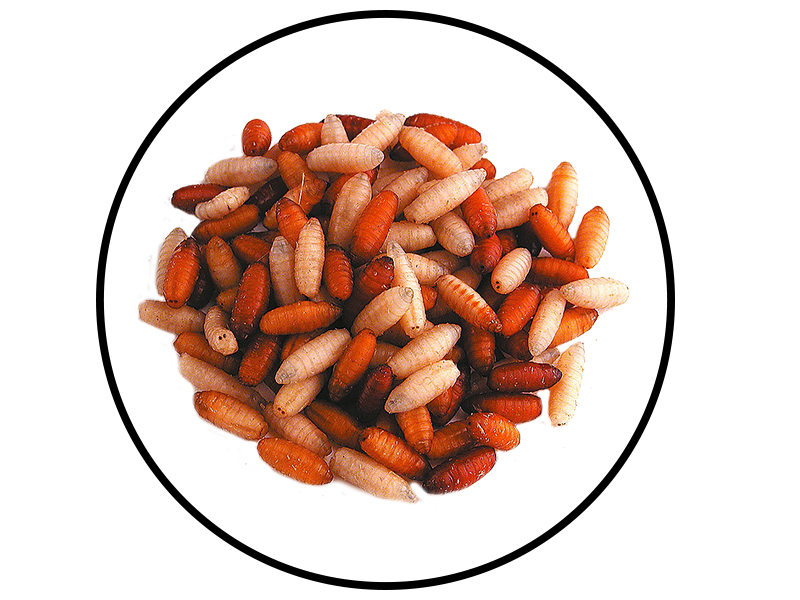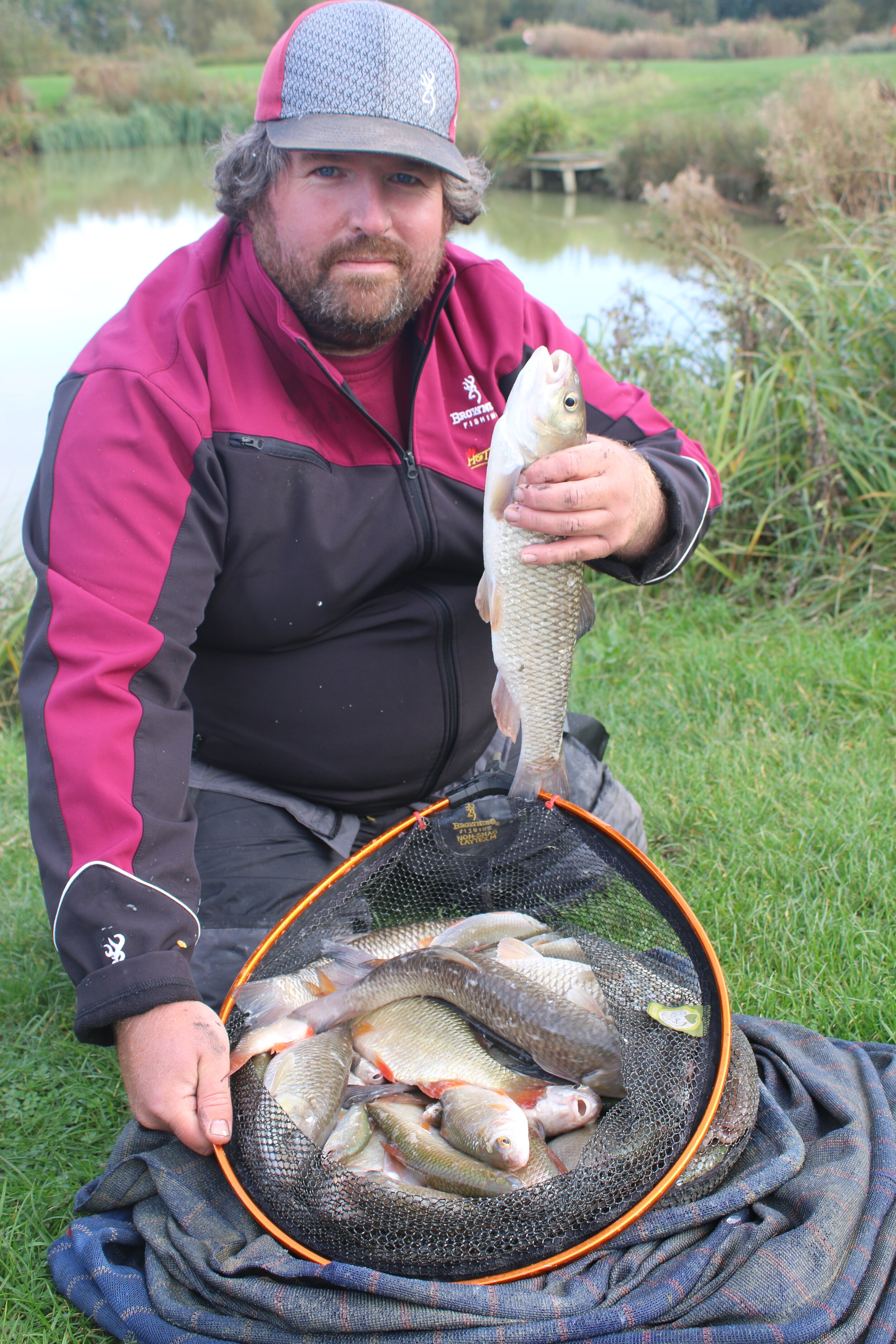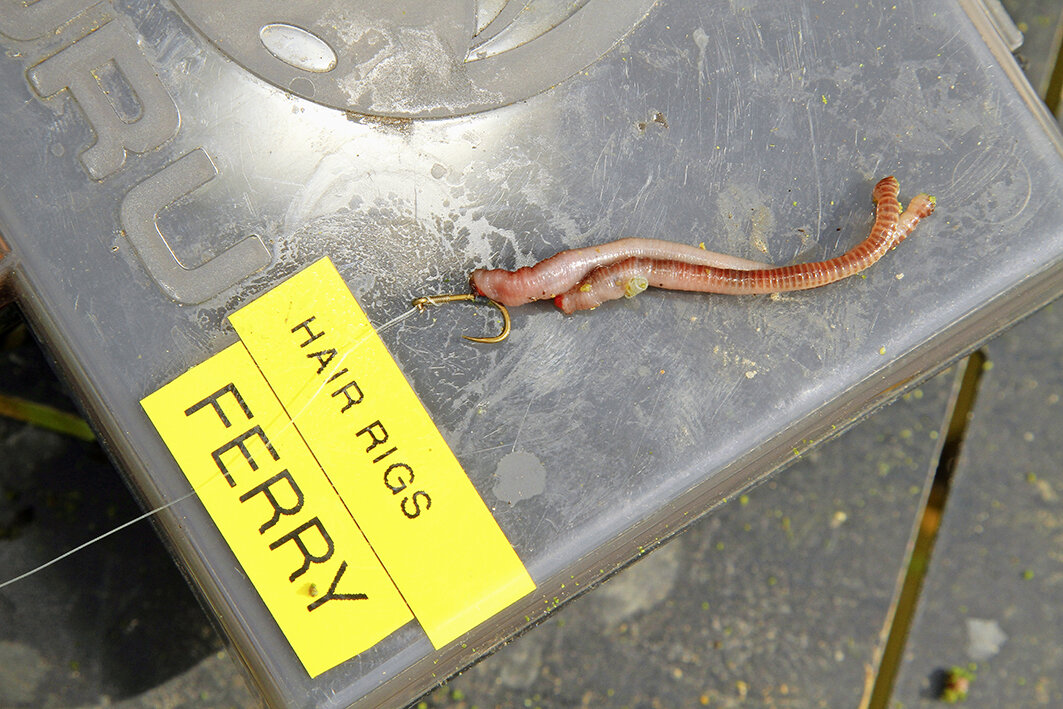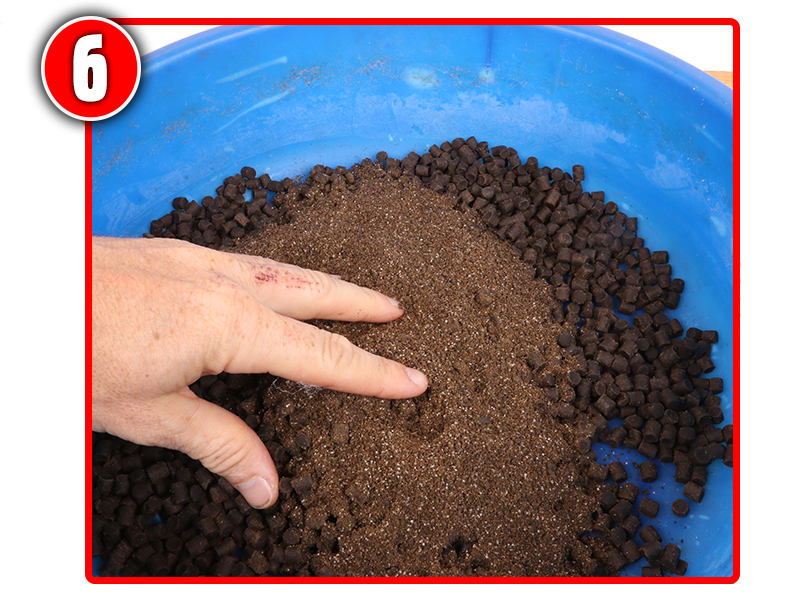Carp fishing with PVA bags
Using a PVA bag when carp fishing has become a very popular tactic for most carp angler's. However there are many ways in which PVA can be used when carp fishing below we will explain some of the best ways you can present your bait while fishing with PVA.
PVA (Poly-Vinyl Alcohol) is a water-soluble substance that can be made into solid sheets, tape and string, or woven to create a continuous mesh-type stocking.
Once in the water, the PVA will dissolve to leave a neat pile of freebies around your hook. Feed introduced in PVA traditionally needed to be completely dry, but ‘PVA-friendly’ oil-based liquids are now available, and won’t melt the PVA on the bank.
What to feed in PVA
The usual advice is to use only dry feed in PVA. However, ‘wet’ baits such as particles and nuts can be used if some dry groundbait, boilie base mix or salt is added.
Pellets are probably the most common filler for PVA bags and are first choice at this time of year.
Try using a brightly coloured pop-up boilie over the top of a small pile of PVA-introduced pellets and your chance of a carp will be good!
Another way to feed ‘wet’ baits is to coat the inside of a solid bag with an oil-based PVA-friendly liquid, then add the damp bait.
String
The traditional way to use PVA, but one that has gone out of fashion recently, PVA string is used to create a ‘stringer’. A number of baits – usually bottom bait boilies are threaded on to the string, which is then attached to your hook.
Rig foam
Although not made from PVA, these melting foam chunks have similar qualities and are used to prevent hookbaits from sinking into a soft, silty lake bed. Being buoyant, they hold the hook off the bottom before dissolving. They also help prevent tangles when using a long hair.
Solid bags
These can be filled with all manner of freebies, regardless of the size of bait used, just as long as the loosefeed is dry or any liquid is PVA-friendly. They should be prepared in advance for convenience, and pierced after tying to remove any trapped air.
Mesh bags
The most popular use for PVA, and easy to tie thanks to stocking cylinder kits that are now available to buy from tackle shops. Mesh bags melt quickly and can be made in different sizes to suit the conditions on the day.
5 Pike fishing bait tips to help you catch more
We recently asked Korum-backed Ed Matthews, how he would go about catching pike from his local stillwater right now. he came back with these five great pike fishing bait tips to help you catch more pike this season.
1) If you’re deadbaiting on a weedy water, the easiest way to tackle the weed is to balance your deadbait using half a polyball. The amount of buoyancy needed will depend on the size of bait used.
This will also ensure that your hooks land facing upwards, away from the lakebed. In addition, on really weedy waters I don’t use anything that could potentially snag in the weed, as this could cause resistance on the take. That, in turn, could result in aborted takes.”
2) Normally, to help locate pike, approach your lake quietly and look for predatory birds such as cormorants and grebes. Their presence will guarantee that prey fish will also be around, and where there are prey fish there are always pike close by.
However, in weedy waters, prey fish have plenty of areas in which to hide so they can be found in pockets all over the lake. I can almost guarantee that if there wasn’t any weed there would probably be two or three areas on the whole lake where all the pike would be, as the cormorants would have balled the baitfish up.
3) My rig set-up is pretty simple really. Mainline is 60lb braid, and I use either a deadbait cigar float or a Korum Dura Bung float down to about 18ins of 30lb wire trace.
I fish 2ft-3ft overdepth and I tighten right down to the float to ensure I see any indications right away. If I fished a slack line I might not get the same immediate indication, especially on a calm day.
4) Fish a swim out. If I get spells when the action slows or stops completely, I’ll change tactics and perhaps put a drifter float on to cover more water.
This also helps me fish much further out than I am able to cast, which will often bring me more bites. Sometimes doing something different can make the difference between blanking and hauling.
5) Something I have been experimenting with lately is Sonubaits Lava. Pike rely on sight and scent to feed, and adding some Krill Lava to your deadbaits can make an ordinary deadbait much more appealing to an inquisitive pike.
Lava is a sticky liquid, denser than water, that creates a plume of flavour and colour around your hookbait. As soon as the deadbait has settled on the bottom, it starts to do its work, breaking down to release its rich scent and attractive colour.
On good days I have found that deadbaits treated with red Lava can single out some better fish. Be warned – It does make quite a mess of your hands though!
Another additive I have used for deadbaits with some success is Sonubaitas squid-flavoured clear pellet oil. As with the Lava, just squirt some into the mouth of the deadbait.
How to make spicy barbel paste
Among the most versatile winter baits are pastes, not only because they leach out their atttraction much faster than tougher baits, but because they break down in a matter of hours if they are not eaten. By using a ready-mixed curry paste it’s very quick and easy to make your own barbel baits with a really strong, spicy flavour that barbel adore.
1) Break a large egg into a mixing bowl. Egg acts as a binder and makes the paste last longer.
2) Add a teaspoonful of the Tikka paste and a similar amount of anchovy paste to one egg. Alternatively, you could use curry powder, but the ready-made mix is much easier to use and has a better flavour.
3) Mix the egg and paste well. Add food dye now if you with to alter the colour of the finished bait.
4) Add boilie base mix or paste powder to the egg. Mix, but stop while the paste is still quite soft.
5) Rest the paste for 10 minutes so it firms up. Now put it into an airtight bag to stop it drying out. Mould some paste around a boilie or, better still, a wafter for a more buoyant bait.
How to catch big barbel on spicy fishing baits
If you want to catch a really big barbel, now’s the ideal time. The fish will be fighting-fit and at their maximum weight. However picking a hookbait that will be able to attract such elusive specimens can be difficult. So check out this great and unique bait to help you catch big barbel right now! Follow Paul Garners steps below for the best results.
GO LARGE
I’m fishing at the most productive times of the day, when I expect the barbel to be feeding hardest, so I will stick to big baits – perhaps meat or boilies, but more commonly big lumps of paste moulded around a smaller boilie so I always have a bait on the hair.
I like a hard boilie as the core of my bait, not because I’m going to be leaving the rig in place for hours on end, but because pesky chub can easily remove a soft bait without you knowing it.
Underwater filming has shown just how often chub will attack a hookbait with hardly a tap on the rod top, especially when using the longer hooklengths common in barbel fishing.
My normal presentation is to use a 12mm boilie as the core of my hookbait and then wrap a lump of paste around this.
The finished hookbait ends up being about 20mm across, quite a substantial bait, but one that a barbel can eat with ease.
You can get an idea of how long the paste wrap will last by dropping a wrapped boilie into a glass of water. Remember, though, that small fish will often peck away at the paste and can demolish it much faster.
You can buy tubs of ready-mixed paste, often with the same attractors as in a finished boilie. These are a handy, albeit expensive, way of starting out with paste fishing.
However, I tend to make my own pastes, using boilie base mix with added spicy additives to boost their effectiveness. Not only is this a cheaper alternative to shop-bought boilies, but it means that I can play around with the additives.
TIKKA TONIGHT
The combination of curry and garlic is a proven barbel-catcher that will catch even when the water temperature is really low.
I use a ready-mixed Tikka paste, which combines all the ingredients that I want and is much easier to use than separate spices. Don’t be afraid to pump up the flavour at this time of the year. I will use a teaspoonful of Tikka paste to each egg used.
Also included is a teaspoonful of pungent anchovy paste to give the bait a fishy kick. Alternatively, why not add some flaked tuna to the paste to boost its fishy smell?
PRECISE FEED
Fishing each swim for a short period of time not only puts you in with a much better chance of locating a group of barbel, but is also a pleasant way to keep warm on an early spring day.
This is certainly active fishing, and I will drop half-a-dozen lumps of paste into a couple of spots that I intend to fish later in the day as a prebait for later on.
Be careful where you put the feed, though, as it can easily be washed away. I like to find swims with a pronounced crease and put the bait just on the slack water side of the swim.
There is no need to use more than just the hookbait when fishing in this way – in fact it might be counter-productive to introduce more bait when you are fishing. Rely on the pungent smell of this paste and you won’t go far wrong, in my opinion!
10 of the best roach fishing tips
There are few finer sights in angling than a specimen roach, or a net of silvers caught on a freezing cold day. To help you have a better chance of catching your best-ever roach we've asked Paul Garner about his top roach fishing bait tips.
I reckon roach are making a very welcome comeback, although often they go unnoticed until caught by accident by carp, bream and barbel anglers.
These accidental catches, though, hint at the fact that rather than being the delicate feeders that we once believed, roach are in fact catchable on a much wider range of baits and tactics.
Choosing the right tactic is key, and it’s surprising how roach in various venues can behave very differently, especially to baits.
Follow my tips and you won’t go far wrong, wherever you may choose to fish.
1) Fresh is best
Roach are one species where I think it is essential to keep your maggots in top condition.
The fresher and softer the bait, the more roach you will catch – it’s as simple as that.
Ask your local tackle shop when they get their maggot deliveries and try to buy yours soon after they arrive.
I then riddle off any sawdust and replace it with maize flour, which softens their skins and gives you the best bait possible.
2) Big baits for big fish
On venues that contain a lot of roach, including some big ones, the easiest way to sort out the specimens is to use a larger bait.
A 2lb roach can easily handle a lobworm, double sweetcorn or a 10mm boilie. You won’t get many bites, but when you do it will definitely be worth the wait!
3) The helicopter rig scores at range
Gravel pit and reservoir roach fishing often means fishing with maggots at ranges well beyond floatfishing distance.
One rig stands above all others for this type of fishing – the helicopter rig, incorporating a Kamasan Black Cap feeder and a 4ins hooklength, baited with maggots.
Remember to clip-up the line so that you are fishing to exactly the same distance on every cast, and re-bait every 20 minutes in order to build up a tight patch of free offerings on the lakebed.
4) fish pellets like hemp
On commercial and carp fisheries roach see an awful lot of pellets in one form or another, and are not slow to latch on to this nutritious food source.
I have had some lovely roach sessions fishing with expander pellets under a fine pole float fished in the margins on venues like this.
Expect to miss plenty of bites, though, as this is very similar to hemp fishing. My advice is to use the softest pellets that you can, as the roach will hang on to these for a fraction of a second longer.
5) Try a method feeder
The Method has dominated fishing for many species, and it has transformed big roach fishing too.
At Lochnaw, in Scotland, this tactic sorted out the specimens – I used a combination of crushed hemp and Dynamite Baits’ roach mix on the feeder to land fish to over 2lb.
6) Hit more with maggots
This old dace fishing trick can be just as useful when you’re after roach.
If you are missing bites when fishing a single maggot, try hooking a maggot through the middle instead of the end. This will often see your catch rate soar.
7) use a dedicated mix
Many companies produce a dedicated roach groundbait, often loaded with crushed hemp, brown crumb and even rock salt, plus a host of herbs and spices.
These mixes are very effective, but
I often like to mix them with some fishmeal-based groundbait too, as there is no doubt that roach love the combination.
A 50-50 mix is a good starting point, with four tangerine-sized balls introduced at the start of a session to kick-start the swim.
8) Bread in rivers
Roach in rivers and lakes are almost like two completely different species.
Stillwater roach can be incredibly picky, whereas their river cousins will eat a far wider range of baits with gusto. Take bread, for example.
For river roaching a piece of flake and a feeder filled with liquidised crumb is often my opening gambit.
Try the same tactics on stillwaters and you are likely to wait a very long time for a bite.
9) Spice them up
Turmeric not only gives maggots a curry-like smell, but darkens their skins to a bronze colour.
Why roach like this flavour so much I don’t know, but a teaspoonful added to each pint of maggots can definitely give your bait a boost, especially when the water is very cold.
You can buy this excellent additive in your local supermarket.
10) hemp is a must
Having filmed roach ‘feeding’ on hemp I am sure that they spit most of it out because of the hard shell. The same grain may be picked up by several fish before finally being eaten.
This behaviour, I am sure, explains why bites when hemp fishing can be very fast and difficult to hit.
You can’t get away from the fact that roach love the taste of hemp, though, and so it is a must in all of my roach fishing.
Boost your pellet bags and catch more
Most anglers will use fishery pellets straight from the bag in their teabags, but they really could do with a boost when the water is really cold. Fortunately, this is easily achieved and takes just a few minutes – just follow my handy guide below.
1) Add a splash of Tiger Nut drink to the dry pellets. This needs to be just enough for a light coating so that is soaked up and slightly softens the pellets.
2) Crush a handful of Strawberry Crush boilies to a fine powder. Boilies are denser than pellets and so tend not to get washed around the swim by the carp so much.
3) Add about 25 per cent crushed boilie to the pellets. Crushing the boilies releases their attraction much faster won’t fill the carp up as whole ones would.
4) Add a pinch of the pellet and boilie mix to a PVA stick but not too much – you want to attract the carp, not give them food to compete with your hookbait.
5) Compress the bait in the PVA stick and tie off the end. For winter fishing you are aiming
to make a teabag around the 20mm-30mm diameter mark.
6) Use a safety boilie needle to pull the hooklength through the side of the PVA teabag and pull the hookpoint gently into the side of this compact PVA stick.
How to make the ultimate cheesepaste!
There are lots of different ways to make cheesepaste, but this method not only produces a very smelly bait with the perfect consistency, but it is also very easy to produce.
It makes enough bait to last for a good few chubbing sessions.
1) Finely grate a quarter-pound of Cheddar cheese and a similar amount of Stilton.
2) Sprinkle half-a-teaspoonful of squid powder over the grated cheese.
3) Add two heaped teaspoonfuls of grated parmesan cheese to the mix.
4) Mix powdered pastry mix with water and a teaspoonful of hemp oil. Knead until it feels like putty.
5) Roll the pastry out flat and add the cheese mix on top (no, you’re not making pizza).
6) Mix and knead the pastry and cheese well until an even consistency is achieved.
Six bait tips to help you catch big fish
What a year 2017 was for big fish! We've asked bait expert Dr Paul Garner to give us his expert opinion on some of the best baits he has used over the past year. Maybe you can take some of these into 2018 and lad yourself some amazing big fish.
SELECTIVE SOFT PELLETS
Tight magazine schedules often mean that I find myself on the bank having to catch fish for the cameras way before the fishing has really switched-on for the year. So it was this spring when, with the water temperature still in single digits, I visited the lovely Milton Lake at Old Bury Hill Fishery in Surrey.
The plan was to catch tench, crucians and perhaps roach using a chopped worm and caster approach. Only nobody had told the fish!
With just a single net roach to my name on a dendrobaena I switched lines to a shallow spot tight to the reeds where I had been trickling in a constant stream of 4mm expander pellets laced with flavour and sweetener. The aim was to pick up a few of the lake’s crucians, but when the float shot under I found myself playing a big roach instead. After that the bites became more timid as the crucians moved in and I spent a lovely afternoon trying to hit as many bites as possible. The odd marauding tench kept me on my toes amid a rapidly growing tally of bars of gold.
The moral of the story was that it is rarely too cold for soft pellets, especially if you flavour them. What I didn’t expect was that, on this day at least, the pellets would so comprehensively out-fish my more natural baits.
TINY BAITS EQUAL BIG BARBEL
The first few weeks of the river season were unusually warm and on the usually prolific River Wye, rolled meat or trotted punched salami scored best with lethargic barbel.
Tiny meat baits have caught me many different species, often of prodigious proportions. For barbel it was more about using a familiar bait in a different way. Regular doses of hemp and punched meat, with a tiny piece of meat on the hair, became my go-to tactic right through the low water of summer.
ALIEN BAITS ON TOP
hunting through the shelves of my local koi emporium a few years back I came across a carp treat that was set to revolutionise my summer surface fishing.
Looking like something out of a sci-fi movie, silkworm pupae are a well-known gourmet treat for pampered Japanese koi. Carp go loopy for these thumbnail-sized floating insects, but straight from the shop they are crispy and break up when you try to hook or band them. Soak them for an hour, though, and they soften up enough to be hair-rigged, yet retain their buoyancy – perfect.
On a magazine shoot for Improve Your Coarse Fishing at Chad Lakes in the Cotswolds the fish were proving difficult to tempt off the top. A few hours later, and with five fish under my belt, it was job done, thanks to my bug-baits.
NOT-SO-DAFT PIKE
Pike are generally thought of as being rather daft and easy to catch, but sometimes, on some venues, I beg to differ. Of the numerous pike that I have caught more than once on lures, not one has ever been caught on the same type of lure twice.
One fish that was caught at least six times over several years by several anglers came out on tactics as varied as a fly, a jig and a crankbait, but never the same thing twice! Coincidence? No way!
The same can apply to deadbaits, and on a busy venue I will swap to unusual species once the pike have been fished for over a few weeks. In early spring, in very cold water, the problem is compounded by the low temperature reducing the metabolism of the fish. Needing very little food, and sometimes failing to pick up baits off the bottom, pike can be hard to catch. Now I always use critically balanced baits in the spring and I catch my share of big pike, like this immaculate 32-pounder from Chew Valley Lake last February.
SIMPLE DAY-TICKET CARP
A bout of illness kept me off the bank quite a bit through the summer, and to say I was itching to get back fishing would be the understatement of the century!
Short-session carp fishing proved to be the perfect medicine, with plenty of bites keeping me busy and some surprisingly good fish putting in an appearance.
My tactics were just about as simple as they come – a hair-rigged wafter boilie on a nylon rig and a lead big enough to cast the required distance.
No pop-ups, Ronnie Rigs or Chods in sight! On these prolific venues the key to catching more than the odd fish was to keep the bait going in. Using a Spomb to thwart the seagulls, a couple of handfuls of Scopex Squid boilies would be fed after every bite to keep the fish coming back for more. Bites would often come as the Spomb was still crashing down, proving that the fish were attracted, rather than repelled by all the racket I was making.
These sessions were brilliant fun and I started filming them for my YouTube channel - dr paul garner. I have lots more day-ticket venues lined up for 2018, including some that hold mightily impressive fish, and you can bet I’ll be using simple baits and tactics.
NEVER BEEN A BETTER TIME
For decades we have treated lure fishing as a second-rate tactic, but take it from me, for electrifying predator action this winter it’s the way to go. Not only will this mobile approach make the best of the short winter days, but there is nothing to touch the adrenaline-inducing ‘hit’ of a fish on a lure.
There’s never been a better time to take up lure fishing. The amount of information available is at an all-time high, so whether you choose to spin, chuck lures or drop shot, you can learn the right way to go about it.
The highlight of my autumn were the incredible perch that I chanced across in a large reservoir. Working a soft plastic Pulse shad close to the bottom I had a faint tap as soon as I stopped winding and let the lure flutter down to the bottom.
After such a gentle bite I wasn’t expecting a personal-best perch to pop up in front of the net but a giant it was, proving the effectiveness of my favourite perch baits.
The best three ways to prepare your bread when fishing
During the cold winter months there is no better bait to use than bread, its flexibility in the way that it can be prepared and used makes it an essential bait to take on the bank with you this winter. We've asked our regular bait expert Dr Paul Garner to show us his top 3 ways of using bread while fishing.
BREAD FEED
In fast-flowing or deep rivers your feed can get washed a long way downstream, taking the chub with it rather than pulling them upstream towards you.
Bread alone will work in water up to 4ft deep, as long as the flow isn’t too strong. Beyond this I will use brown crumb to stiffen the feed so I can form it into soft, fast-sinking balls. A cloudier mix that breaks up well can be made by handfuls of instant dried potato, such as Smash, to the mix.
When I get to the bank I cover a broken-up loaf or two with river water, leave it for 10 minutes, then squeeze it in an sieve or carp sack that holds back the fine particles but lets the water pass through.
Bread can be quite tricky to use for the first time. Stick with it, though – as a cheap and effective chub bait it really does take some beating.
Tear the bread into small chunks and soak in river water.
You can use neat bread for shallow swims, where it will reach bottom.
Allow the crumb a few minutes to soak up the excess water.
Tear the bread into small chunks and soak in river water.
For deeper or fast water add brown crumb to stiffen the bread.
The finished feed holds together and only breaks up on the bottom.
ON THE HOOK
You can mould flake around the hook shank for chub. Their cavernous mouths will easily handle a 50p-sized piece. Match hook size to the bait – for big baits a size 8 is about right, for large punch go down to a 12.
I feel that a large piece of punched bread is much more effective than flake. Because the punch evenly compresses the bread it tends to stay on well, even when just nicked on to the hook.
Flake, pinched around the hook shank, can stay on better, but at the expense of producing a soft, neutrally-buoyant bait.
Traditional bread punches tend to be a bit small for this job. I use 10mm punches, and will often cram to or three pieces of bread on to a size 10 hook to give a more substantial bait.
Larger bread punches are best for chub fishing – or make your own.
The dry punched baits might look out of proportion on the large hook...
Double or triple-punch the bread to build up the thickness of the bait.
...but in water they quickly expand and cover much of it.
WET BREAD
Sliced bread can be made a lot more user-friendly by wetting and compressing it the day before you go fishing. This produces a much denser bait that holds together.
First, remove the crusts from a few slices of thick white bread then soak them for a minute in cold water.
Remove the slices of bread and place them on a board covered with a couple of pieces of newspaper.
Add more newspaper on top, along with another heavy board to compress the slices. Leave overnight and by morning you’ll have slim slices of damp bread that make perfect hookbaits.
Remove crusts and place each slice in a tub of water for a few seconds.
Cover with more newspaper and lay a piece of board over the top.
The bread should be compressed and damp to the touch.
Lay the wetted slices of bread on a few sheets of newspaper.
After a few hours, remove the board and unwrap the slices.
The bread is tougher than normal flake and can be torn into pieces.
How to make a high-attract stick
PVA can be used with a wide range of different dry additives, and even liquids if they are ‘PVA-friendly’. This is one of my favourite stick mixes, but don’t be afraid to include your own favourite ingredients.
1) Grind up a handful of boilies into a fine powder. You can then either use these neat or mix them 50-50 with breadcrumbs.
2) Add your powdered additives to the boilie crumb. Make sure you mix well to evenly distribute the powerful attractors.
3) Add a few drops of boilie dip and mix well. The liquids will coat the boilie crumb and give an instant hit of flavour into the water.
4) Put about a tablespoonful of the boilie crumb into a fine PVA stick and compress it well down, using a plunger if possible.
5) Tie off the end of the stick – the finished PVA should be about 20mm in length, just enough for a single mouthful.
6) Thread the stick on to your hooklength and pull the hookpoint into it. A contrasting colour of wafter hookbait will really stand out.
How to prepare method pellets
Preparing micro pellets for the Method feeder is a simple process, even if you want to boost them with liquid and powdered additives.
Choose a brand of ‘sticky’ pellet for best results, or add a handful of groundbait to fishery pellets to ensure they bond together well...
1) Add liquid additives to the mixing water and stir well to ensure that they are evenly distributed.
2) Add the water to dry pellets – as with groundbait, add the water slowly and allow the pellets plenty of time to soak it up fully.
3) When the pellets still feel dry but bind together with a squeeze, stop adding water. After 10 minutes add more water if need be.
4) Add powdered additives to the pellets last and ensure that they are evenly distributed throughout the bait by mixing vigorously.
The 10 best chub baits
If one species can be relied upon above all others to keep providing brilliant sport right through the winter it has to be chub.
Whether the rivers are low and clear, or high and murky, chub can be caught, although you have to be on top of your tactics to score consistently.
No other species can be caught on such a wide variety of baits and tactics as chub – you really could spend a lifetime getting to know each and every option, but here are some of my favourites that have been honed to catch chub both large and small whatever the weather may throw at us.
GIVE THEM A LIFT
If you have ever suffered from the frustration of ‘unmissable’ chub bites that have seen you striking into thin air then join the club!
This has long been part and parcel of fishing with larger baits, especially boilies, because the chub can easily pick them up in their lips, leaving the hook hanging outside the mouth.
This is especially true if you are hair-rigging, so my first suggestion would be to switch
to paste and bury most of the hook inside. Mould the paste around a piece of cork so that it only just sinks and you will hit a lot more bites.
A SINGLE MAGGOT
The colder and clearer the river, the smaller the bait I will use for chub. When it’s like this the fish won’t be inclined to gobble up a big bait, but feed regularly with maggots and you can get the shoal going.
To avoid spooking the chub by running a float over them, try a small Blackcap feeder coupled with a 4ins hooklength and a size 18 hook, with either a single real maggot impaled on it, or its fake counterpart fished on a short hair.
WRAP BOILIES
If I had to use just one boilie for chub it would have to be Scopex Squid – the unmistakable pong of squid powder really turns chub on.
Rarely, though, will I use a standard boilie on the hair. Instead, I wrap a 12mm wafter in soft paste to give it extra pulling power.
A small PVA mesh stick filled with broken-up boilies and bits of paste can also be added to supply some feed tight to the hookbait.
GO LARGE IN FLOODS
If the river is high and coloured then a big bait is going to score best for chub.
Go for a matchbox-sized lump of meat, a paste-wrapped boilie, a big lump of cheesepaste or steak.
Anything, as long as it is big and smelly, will put you in with a good chance of success. Forget about loosefeeding in these conditions and stick to just the hookbait.
PREBAIT WITH PASTE
Chub are suckers for light prebaiting in the days leading up to your fishing. I can’t think of any species that responds so quickly to an easy meal.
The only problem can be estimating how much bait to introduce, especially if other people are fishing the same stretch.
An easy answer to this is to bait up with paste, as this will last only a couple of hours in the water before it is either eaten, dissolves, or is eaten by small fish.
A dozen nuggets of bait per swim is all you need to make a difference.
TRY A DEADBAIT
Big chub grow fast on a high-protein diet that often includes dead fish, and a great many outsize fish have been caught on deadbaits meant for pike and zander.
Try a section of a soft fish, such as sardine, fished on a single hook.
A chunk of lamprey about an inch long is my most successful chub deadbait, and works particularly well on rivers that sustain a good migration of these creatures.
BREAD HOOKBAITS
I know a lot of anglers who struggle using bread on the hook. Pre-packaged bread tends to have a very light texture, full of holes, that breaks down really quickly. By contrast, a proper baker’s loaf will be heavier and stay on the hook better.
The best hookbait of all, especially for trotting bread, is Sensas Paindor Bread.
This dehydrated bread needs to be soaked in water before use, but once prepared it stays on the hook fantastically well.
MEDUSA RIG
Lobworms can often be difficult to get hold of in the winter, just when they come into their own for chub.
Dendrobaena worms are a poor substitute, but try several on the hook or, better still, a large maggot clip, and your results will improve.
Four dendras on a clip will create a big bait that chub cannot resist.
MASH IT UP
Put a loaf of sliced bread in a bucket and soak it in cold water for about 10 minutes, before draining off the excess by gently squeezing it.
Mash the bread up and you have the basis for a fantastic feed that creates a cloud of particles as it breaks up and is washed downstream.
For deeper rivers, mix a small amount of brown crumb with the bread mash so that it holds together better and reaches the river bed before breaking up too much.
BAIT AND WAIT
Catching a chub too quickly can be the kiss of death on many rivers, as the rest of the shoal will spook, but it can be difficult remaining patient.
I overcome this by starting to introduce a pouchful of maggots as soon as I arrive at my peg and then keep a steady supply of grubs going in while I am setting up my gear.
By the time you come to make your first run through the swim the chub should have settled – expect that float to dip on the first trot through.
how to make pellet boilies
A cheap and easy way to make your own boilie hookbaits is with ground halibut pellets. This might seem like a lot of effort to go to to make what in effect are just soft pellets, but these are very tough and easy-to-use hookbaits that can be flavoured, coloured and made more buoyant – in effect, customised to your liking.
1) Use a coffee grinder (preferably one bought solely for your own bait-making use) to reduce a couple of handfuls of halibut pellets to a fine powder.
2) Break a large egg into a bowl and add a teaspoonful of hemp oil, half a teaspoonful of Umami paste and four drops of Black Pepper Oil.
3) Slowly add the halibut pellet powder to the liquid egg until the mixture takes on the texture of a soft paste such as you might use on the hook or as a boilie wrap.
4) Boil the sausages for around one minute and then allow them to cool on a piece of kitchen roll to soak up the excess moisture.
5) Boil the sausages for around one minute and then allow them to cool on a piece of kitchen roll to soak up the excess moisture.
6) Cut the sausages into chunks and freeze them until needed. A few drops of hemp oil added to the tub will boost the baits further.
How to use hemp correctly when fishing for roach
Hemp is still a bait that so many anglers steer clear of when it comes to fishing for roach.
The seeds are fiddly to get on the hook, and when the angler finally gets a bait in the water he’s unable to catch anything.
That’s far from the truth. It may not every day that sees hemp work, but when you’ve got a swim producing a fish a cast on maggots and casters, there’s no reason why changing to hemp should lead to a halt in bites – provided of course, you’ve been feeding hemp from the word go.
This week’s coach is a real blast from the past – Pete Jayes. The Leicester angler has enjoyed a glittering career stretching back to his days with Ivan Marks and the Likely Lads.
Here are his top tips for catching big roach on ‘the seed’ this autumn…
Present it correctly
“Whereas maggots and casters are best fished overdepth, I think hemp works brilliantly when presented just off bottom and run over just a few feet of a river swim as opposed to way down the peg.
“I try and get the grain on the hook to act in the same way as the loosefeed underwater. Hemp on the riverbed won’t move with the flow, due to its weight, so why should the hookbait?
“I think roach line themselves up in the flow waiting for the hemp to arrive – if the bait acts suspiciously they won’t look at it.”
When tares work
“I never fish hemp without having a few tares with me because they are a brilliant hookbait that picks out the bigger roach in the swim. They are a much bigger bait than a grain of hemp, and they’re also easier to get on the hook.
“Once the roach are lined up on hemp it’s time to try a tare on the hook. I prepare my own, but to make them even softer I will freeze a few and then defrost them before use.”
Different rigs
“I always have two pole rigs on the go for hemp work because no two days are ever the same.
“You have to try different depths and shotting patterns to make the hookbait behave as much like the loosefeed as you can.
“I’ll fish a 0.4g bodied float plus a much lighter 4x14 slender Preston Innovations Chianti model. Both are shotted using nothing larger than No10 shot, as this allows me to move them up and down the line for different presentations. You can’t do that with heavier shots.”
feeding
“Varying how many grains of hemp you loosefeed is the road to ruin. I reckon roach like a constant stream going in – the more regular the feeding is, the better the fishing will be, so I fire in around 12 grains every run through and never alter this.
“Should I think that a change needs to happen, this comes by altering the shotting on the rig rather than how much I am feeding.”
Light lines, small hooks
“In keeping with the delicate presentation that I am trying to achieve, my lines and hooks have just as much finesse.
“A hook that’s too big and a line that’s too thick will make the hookbait act unnaturally underwater, so typically I fish 0.10mm mainline to an 0.08mm hooklink.
“Your hooks should be very light as well, but they need to have a wide gape to help the hemp sit properly.
“For me the best out there is a Kamasan B511 in a size 20 or 18.”
The best bait to use for roach
Like most anglers I love fishing for roach, and while other species may grab my attention throughout the year, my season wouldn’t be complete without a campaign for these amazing fish.
We often take roach for granted, given that they can be found in almost every river, lake or canal, but this disguises the fact that they are superbly adapted to such a wide range of different environments.
One of the factors that enables roach to be so successful is their ability to eat a wide range of different natural foods. If you look at the mouth of a roach it isn’t specialised, which hints that roach are the all-rounders of the coarse fish world. Roach are equally adept at feeding on small snails as they are bloodworm.
Emerging insects will get them to rise in the water column to feed, whereas an abundance of caddis larvae may seem them feeding on the bottom. Roach will even chomp mouthfuls of algae from the surface of water plants and stones, even though they can only digest the tiny animals that are hidden within.
It should be no surprise that roach will feed on a wide range of different baits too, but choosing the right one for each situation can make all the difference to your catches.
By thinking about how the roach are behaving in each season we can see why our tactics need to change throughout the year.
AUTUMN
This year I am expecting some great river roach sport, thanks to the regular rain giving running waters a welcome tinge of colour.
This definitely improves roach sport, which reaches a climax as the light-level falls in the evening. Seed fishing with hemp and tares is what autumn evenings were made for, although a handful of casters for hookbaits will see bites often easier to hit and can bring a bigger stamp of fish.
Other alternatives to try at this time of the year are stewed wheat and groats, both very cheap to buy and easy to prepare, along with elderberries that make a useful hookbait.
Feeding little-and-often is the key with all of these baits. A pinch of seeds every minute will get the roach competing. If you are impatient, try starting with a maggot on the hook, as it can take a while for the roach to feed confidently on seeds.
At this time of the year the roach are often feeding on tiny black water snails, which I am sure explains the effectiveness of these dark baits.
WINTER
The depths of winter are my favourite time to fish for roach because they can be relied to feed in conditions that most would regard as hopeless. In fact, really cold weather can be the best time to target specimen roach because, for some reason, the small fish will go off the feed, but the specimens will still take a bait, especially in the first hour of darkness.
With small fish out of the equation, this is the time of year to use maggots both as feed and on the hook. I like to carry a mixture of white and red grubs, normally flavoured with pineapple, and use a combination of the two colours on the hook.
For river fishing you may find that dace and chublets make maggot fishing tricky. If this is the case then switching to bread can be more selective. Rather than use flake, as many roach anglers advise, I tend to use an 8mm punch of bread instead, finding the smaller offering more acceptable in the cold. Feed a mixture of fine punch crumb and liquidised bread that has been dampened down enough to hold together when squeezed firmly.
With natural food at a seasonal low, roach have to use all their resourcefulness to find enough food in winter. Often they will be full of algae, which has little nutritional value, but which does hold some tiny invertebrates that they can digest. I am sure that it is the lack ofbetter quality natural food, combined with the desire to feed, that makes roach so catchable in the depths of the winter.
SPRING
Water temperatures tend to rise much more slowly than air temperatures, so by the time my spring tactics come to the fore, the rivers will have closed and so my roach fishing will take place on stillwaters. With spawning taking place around mid-May, the roach will be looking to eat well at this time of the year in order to build up their reserves. Larger baits such as worm and caster can be the roach angler’s best friend during this period. Try using a cocktail consisting of half a dendrobaena worm tipped with a caster on a size 14 hook.
Evening fly hatches will see roach shoals coming up in the water and often topping on the surface at dusk. Try fishing two casters on the hook, which is a slow-sinking hookbait, and feed pinches of caster over the top to attract the larger roach.
SUMMER
Very few roach anglers bother fishing for the species during the summer, but they could be missing out. A lot of big roach are accidentally caught by carp anglers using particle baits and mini boilies so I would base my tactics around these baits.
I have found sweetcorn particularly effective on rivers during summer. Try fishing the first couple of hours into darkness with a light scattering of grains and some hemp. This has worked particularly well for me.
Mini boilies are probably the most selective big-roach bait there is. I stick to 10mm baits, given the relatively small mouth of even a two-pounder.
Best winter baits for fishing
For many anglers, now is the time when sport is at its very best.
Most species are feeding up hard to pack on weight for winter, and a well-presented bait will see plenty of action. We start with 15 autumn-gold nuggets of advice from big-fish expert Dr Paul Garner...
1) Try dead maggots or worms
Two baits stand out for crucians right now – two dead maggots fished over a light scattering of groundbait can work wonders, but a close second comes half a dendrobaena, hooked at the broken end to leak off the juices.
2) It's a wrap for barbel
When boilie fishing for barbel I rarely cast out without wrapping some matching paste around the hookbait. This can work wonders if the fish are proving finicky. A useful trick is to use a 12mm hookbait wrapped in paste, but feed 15mm baits.
3) Gob-stoppers trick wily carp
With everyone using boilies of 18mm or less, you can fool wary carp by going large and 24mm or even larger baits. Scale up your hook size ti match the big bait.
4) Enjoy traditional roach sport
Many of our larger rivers are teeming with roach at the moment. One of the nicest ways of catching them is to use loosefed hemp with prepared tares on the hook.
Start with a pinch of hemp every cast and fish a matching grain on the hook. Once you start getting bites regularly swap to a tare and your reward should be a bigger stamp of fish.
5) Big bream are feeding up
A windy autumn can see shoals of big bream feeding hard. I lay out a big spread of bait to hold the shoal.
Into the mix go a tin of sweetcorn, two pints of dead maggots, some mini-boilies and soaked flaked maize. Bind the lot together into balls with a mix of brown crumb and layers mash.
6) Mid water baits for Rudd
For consistent autumn rudd sport try using a 10mm pop-up or a lump of breadflake on a 12ins-36ins hooklength, so the bait is presented in midwater
7) Stock up now
Get your deadbaits stocks sorted now to ensure a ready supply for winter. Big smelts are always in short supply, so order early.
Split bulk baits into small airtight bags and freeze down. Dip each bait in cold water before freezing, as this will stop them getting ‘freezer burn’.
8) swap to a cone
A pellet cone is a much neater presentation than the Method feeder, and really comes into its own in the coming weeks, especially on venues where the carp have seen it all over the summer months. Vary the size of the cone to control the amount of feed you introduce.
9) The subtle snowman
Very often carp never actually get the hook into their mouths, just the boilie. This can be even worse with a snowman presentation. So try my ‘subtle snowman’ (below), made by cutting a 15mm boilie and a 15mm pop-up down to form a single back-to-back bait.
10) Feed, feed, feed for chub
The key to unlocking brilliant autumn chub sport comes down to how you feed. The simple solution is to drip-feed as regularly as you can. This could be as little as three pellets or maggots every few seconds.
11) Fry-feeding perch
Now is the time to target perch, which predate heavily on small fish which are in the margins over the next few weeks. Use small lures for this – a selection of bright green and more natural hues.
12) Go soft for roach
On many fisheries roach have developed a love of pellets. This can cause problems with fast, hard-to-hit bites. This phenomenon is simply down to both baits being hard, and to combat this try using soft hooker pellets – I find 4mm baits are best.
13) Flavoured meat in floods
Try to coincide barbel trips with the river falling back after a flood. If you have to fish as the river rises, stick to a straight lead and a large smelly bait such as Crab & Krill flavoured luncheon meat.
14) Slug it out for chub
Dew-laden mornings will see hundreds of slugs and snails attacking your garden plants. Rather than chuck them over the neighbour’s fence, why not collect them for an afternoon’s chub fishing?
15) Try red corn down the edge
A float down the edge works for carp that feed in the margins at dusk.
Add a few drops of boilie dye to a tub of corn the day before fishing and you will be left with a lovely dark-red bait that is eaten with enthusiasm.
How to make paste for carp fishing
Many anglers think that paste is for commercial carp fishing only when really it can be used in all types of carp fishing and is definitely a worthwhile tactic to look at next time you are on the bank. We've gone to paste expert Colin Spencer who will real how he has perfected this simple and extremely effective bait
No-shot rig
“One of the most frustrating elements of paste fishing is trying to work out what a bite is. The float will constantly bob around when there are carp around the hookbait, but you are looking for it to dip quickly.
“My rig has no shot down the line, with the weight of the paste cocking the float. A fairly slimline float works best, typically a 0.2g version threaded on to 0.17mm mainline straight through to a size 16 Guru Pellet Waggler hook.”
Vary your paste
“If I am getting plagued by small fish or I’m having to wait a while for bites I’ll stiffen some of the paste up by adding more groundbait.
“If the fish are coming thick and fast then I’ll do the opposite and add more water to a batch to make it slightly sloppier.”
Accurate feeding
“Feeding is just as important as the hookbait. On a prolific venue, don’t feed much or you’ll be dogged by foul-hookers and line bites. I just place a small amount of corn and pellet in a pole cup, place my paste hookbait on top and cup it all into my target zone.
“Then I’ll repeat this process after each fish.
“I’ll stop feeding altogether for a while if I have a run of foul hookers in order to force the fish into taking my hookbait.”
Make Colin's paste
Pour a whole bag of Dynamite Baits Green Swim Stim groundbait into a shallow, round bowl.
Add four pints of lake water to the groundbait.
Mix vigorously so the water is evenly distributed.
After 15 minutes the mix will have stiffened up – perfect.
Mould the paste around a size 16 Guru Pellet Waggler hook.
Best bait to catch bream on
When it comes to trying to bag up on bream, it's difficult to know what the best bait to use is. Wonder no more as we have gone to bait expert Dr Paul Garner to find out what the best bait is when it comes to bream fishing.
On a natural river or gravel pit, 100lb of fish averaging 4lb is my benchmark for a seriously good session. My tactics are nothing revolutionary, but I do make a few tweaks that make a significant difference to my results.
The centre of attraction
Bream are big fish that make a lot of wake as they move around – this can send groundbait and pellets in all directions. Rarely will a Method feeder deposit a neat pile of feed next to the hookbait, except if a fish cruises in and picks it up immediately. How far the bait spreads out and how long this takes depends on the number of bream in the swim.
To combat this I pack some of the bait tightly on to the feeder and either leave the hookbait hanging free, or load it right on the outside of the feeder. Try it – your catches are sure to improve.
Hookbait choice
Boilies and pellets seem to be becoming just as high up the menu for bream as they are for carp, but these baits are not always my immediate choice. Sweetcorn is another very effective bream bait – and underused at that.
With care, the classic combination of corn and a dendrobaena worm can be effective, but take care if you are fishing at range, as the shock of the feeder hitting the water can dislodge even these tough worms.
A bunch of dead maggots is another useful alternative. I prefer red, as they stand out less well, making them less vulnerable to the attentions of silver fish.
Four dead maggots on a size 12 hook is a formidable bream bait, especially when the water is clearer than I would like.
I keep pellet hookbaits relatively small for bream. An 8mm pellet is about right, even for big slabs. Only when I’m targeting double-figure fish will I go bigger than this, as I feel I miss fewer bites on the smaller baits.
Boilies follow a similar rule. An 8mm or 10mm bait is ideal for bream, preferably a wafter, as I am sure that I hook more fish on these semi-buoyant baits.
The flavour of the boilie is almost irrelevant, as I will be boosting it anyway and this will mask the locked-in smell.
Bream feeds
Pellets revolutionised bream fishing and today it would be difficult to think about not using these fishmeal-based baits.
Within reason, the more oily the pellets, the more bream will be attracted to them. Halibuts are perfect, but expensive to use on their own, so if I want to prebait, for example, I will use them in combination with cheaper baits, such as corn and flaked maize.
A spod is the bream angler’s best friend when fishing at range. If you clip up at the same distance as the rods that are actually fishing it’s easy to hit the spot every time, giving you a precisely controlled bed of bait. A spread of bait can be achieved in just 10 minutes, and it’s far more accurate than using a catapult. A bag of pellets and two tins of corn will be plenty for a day session or overnighter, as this will be topped up with bait from around the feeder.
Plain brown crumb is the ideal base for groundbaits, especially if you combine it with liquid molasses to produce a classic bream combination. I like to use a 50-50 mix of crumb and a fishmeal-based groundbait such as Sensas Crazy Bait Gold, Dynamite Marine, or Sonubaits Supercrush.
Sticky sweet feed pellets
Combining savoury fishmeals with sickly-sweet liquids might seem strange, but bream love the unlikely mix. I guess that the sweetness takes the edge off the bitter taste that many pellets have, especially those that are high in oil. This combination creates a potent feed pellet, ideal for spodding out or using on a Method feeder.
Use a coffee grinder to reduce a couple of handfuls of 6mm feed pellets to a coarse powder.
Add two tablespoonfuls of demerara sugar to the pellet powder and mix well.
Dissolve two tablespoonfuls of liquid molasses in a pint of lukewarm water.
Add a teaspoonful of liquid betaine to the water. Bream love the stuff!
Soak a bag of 6mm feed pellets in the liquid for six minutes, then pour off any excess water.
Add the powder mix to the damp pellets and shake to evenly coat the pellets in the powder.
Fishing with hemp and casters for barbel
When rivers are low and clear and the chub and barbel play hard to get there’s one fishing bait that I keep up my sleeve. The classic combination of hemp and casters can send even the most wary river fish loopy, and with practice you can work them up into a feeding frenzy. The key to this style of fishing is to be confident in what you are doing…
Keep the cost down
Big fish love the taste of casters, but they can be expensive. For a full day’s fishing I would reckon on taking four pints, and maybe double that of hemp. Buying hemp in bulk and preparing it yourself keeps the cost down, and any left-over bait can be frozen and kept for the next trip, as I find both baits just as effective when they have been stored in this way.
Sit on your hands
It’s possible to get immediate bites when fishing hemp and caster, but this isn’t always a good thing. One benefit of using any small bait is that the fish will gain confidence in feeding on it over time.
The longer you can sit on your hands before catching that first fish, the more confident they will have grown and potentially the more you will catch. Think of this style of fishing as feeding a line, but not fishing it until later in the day. The longer the fish have to settle on that line, the more readily they will bite.
There are a couple of ways you can slice this cake. If you want to keep busy and the river is large enough, why not spend a couple of hours running a float down the inside line while feeding farther out? Alternatively, and often the only viable approach on small rivers, feed hemp and casters and don’t start fishing for an hour or more. It’s surprising how quickly time passes, and by feeding as soon as you arrive, by the time you are ready to go plenty of time will have already have elapsed.
At close range you’ll probably be able to loosefeed hemp and casters by hand or catapult. This creates little disturbance and creates a line of feed trundling down the swim.
In deeper or faster rivers a bait dropper makes life much easier – let it settle for a few seconds before lifting it out to give the bait time to escape tight to the deck.
On big rivers, switch to a blockend feeder and make regular recasts before attaching the hooklength. Aim at the same spot every cast and look out for tell-tale line-bites that mean the fish are nosing around.
Hooking casters
I keep a handful of casters back from the main feed and store them in a bait tub filled with water to keep them fresh and stop them turning.
Unless I am loosefeeding I will mix the hemp and casters together and feed them like this. Because they sink at different speeds, keep them apart if you are loosefeeding.
Three or four casters on a size 10 hook don’t look too unappealing, but there are better ways to present this bait that eliminate problems with small fish.
A favourite trick is to superglue three or four casters to a short hair rig. This is particularly effective when feeder fishing for barbel and not only keeps the bait on, but gives you a more substantial bait.
My normal hook choice is a forged size 10. I glue the casters to a piece of rig tube on the hair, which gives a stronger fixing. Alternatively, thread a plastic caster on to the hair and glue the bait to this.
Plastic casters are quite buoyant, so three will counterbalance the weight of the hook, making it easier for the fish to pick up. Artificial casters are my go-to hookbait when feeding these baits.
How to glue casters to a hair rig
Rather than try and cover every way that you can hook casters, let’s look at some of the best ways of presenting this bait for larger fish, such as chub and barbel.
Thread a 10mm length of 1mm diameter rig tube on to your hair to form the base that the casters can be stuck to.
Dry a pinch of casters on blotting paper to remove any moisture.
Add a blob of superglue gel to the tubing.
Carefully glue two casters side-by-side to the base of the rig tubing, like this.
Once the glue has started to set, add two more casters to the top of the tube.
TWO OTHER TRICKS TO TRY...
Fake Casters
Simply hair-rig two to four rubber casters sideways on. Use a size 12 hook for two baits, a 10 for three and an 8 for four rubber baits.
Bait Bands
Attach bait bands to a hair rig by tying them into an overhand loop. Casters can be added to each of the bands using a banding tool.
How to make a great bream spod mix
Dynamite Baits specialist Paul Elt has got a great bream spod mix recipe that will pull the slabs into your swim and is a key part of you trying to land a specimen bream this season. Follow our simple step by step guide below to create this irresistible spod mix.
Mix 1kg each of Dynamite 6mm Halibut pellets and 4mm Halibuts.
Add a bag of CSL Spod Mix to the 2kg of pellets.
Two or three tins of corn give great visual appeal to the mix.
Half a jar of Frenzied Hemp goes into the mix, plus all the juice.
Finish off with a good glug of CSL Liquid Carp Food.










